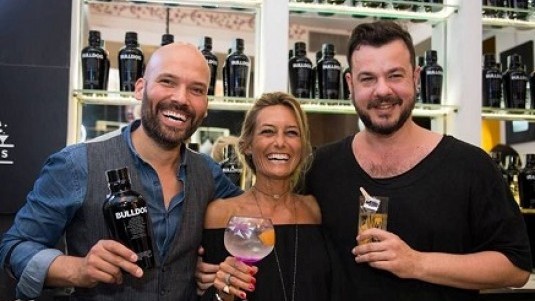The Alchemist (4): Bulldog

The last Master Class at The Gin Corner in Rome’s Hotel Adriano was again hosted by hotel owner Barbara Ricci and Patrick Pistolesi, The Gin Corner and Café propaganda’s Bar Manager. The course wound up with another top-level gin, Bulldog, for which Samuele Ambrosi is the Brand Ambassador. And it was he who again brought us back to the ‘Gin Lane’ of the 18
A prime example of this is Bulldog, an ultra-premium gin that was the brainchild of Anshuman Vohra, a New York banker of Indian origin who, inspired by his travels, decided to create a gin with 12 botanicals, some of which were a novelty. In order to make his vision a reality, he collaborated with one of the world’s most famous distilleries, Grendall’s Distillery, and benefited from the help of an exceptional master distiller, Joanne Moore.
The gin is made with Norfolk wheat, pure, clean water from Lake Vyrnwy (Wales) and – aside from coriander, iris, juniper, Angelica, almond, currant, lemon, licorice and lavender – three unusual botanicals: lotus flower, Turkish white poppy and longan, also known as Chinese dragon eye.
The result was a fine gin with citrus and floral notes that give the mouthfeel elegance and great freshness.
When asked how to serve the perfect gin, Ambrosi’s advice was:
Bottle: ice cold.
Glass: also iced, a balloon or tumbler.
Straw: never because it puts too much distance between he nose and the glass and sensing the aroma is one of most important factors of tasting.
Ice: it must be abundant, better in big ‘iceberg’ chunks because there is less contact between the surface and the gin.
Garnish: grapefruit or orange because they channel and ‘open’ the gin.
For those not convinced of the miraculous (check out the benefits of juniper) qualities of gin, aside from how it refreshes on a hot summer’s day in a good gin tonic, or just dismisses it a too ‘heavy’ to sip as an aperitif, Samuele Ambrosi made an interesting observation: “A good gin tonic needs only 5cl of gin, which means that a gin tonic is no more than 10% alcohol, less than a glass of wine”.
So mix yourself a nice gin tonic!
If not, as Hogarth showed us, there is always beer. Nothing else, take the word of a sommelier.

 English
English







